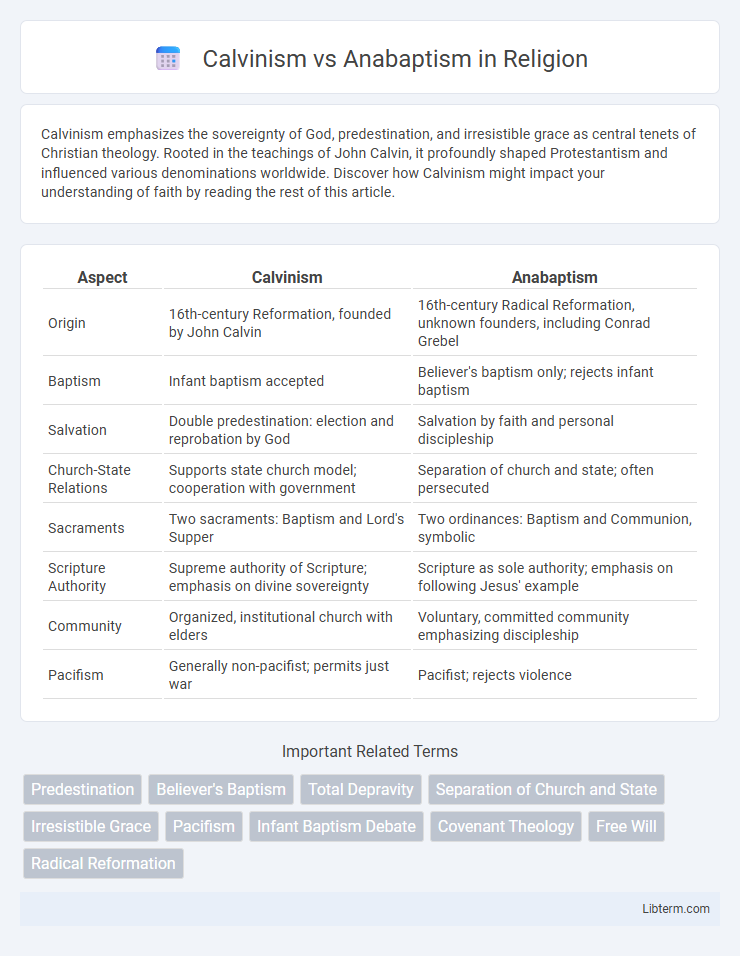Calvinism emphasizes the sovereignty of God, predestination, and irresistible grace as central tenets of Christian theology. Rooted in the teachings of John Calvin, it profoundly shaped Protestantism and influenced various denominations worldwide. Discover how Calvinism might impact your understanding of faith by reading the rest of this article.
Table of Comparison
| Aspect | Calvinism | Anabaptism |
|---|---|---|
| Origin | 16th-century Reformation, founded by John Calvin | 16th-century Radical Reformation, unknown founders, including Conrad Grebel |
| Baptism | Infant baptism accepted | Believer's baptism only; rejects infant baptism |
| Salvation | Double predestination: election and reprobation by God | Salvation by faith and personal discipleship |
| Church-State Relations | Supports state church model; cooperation with government | Separation of church and state; often persecuted |
| Sacraments | Two sacraments: Baptism and Lord's Supper | Two ordinances: Baptism and Communion, symbolic |
| Scripture Authority | Supreme authority of Scripture; emphasis on divine sovereignty | Scripture as sole authority; emphasis on following Jesus' example |
| Community | Organized, institutional church with elders | Voluntary, committed community emphasizing discipleship |
| Pacifism | Generally non-pacifist; permits just war | Pacifist; rejects violence |
Introduction to Calvinism and Anabaptism
Calvinism, founded by John Calvin in the 16th century, emphasizes predestination and the sovereignty of God over all aspects of life, shaping Reformed theology and Protestant doctrine. Anabaptism arose during the Radical Reformation, advocating for adult baptism, separation from state influence, and a pacifist lifestyle, distinguishing itself from both Catholicism and other Protestant movements. Both movements significantly influenced Christian theology and practice, with Calvinism impacting many Western churches and Anabaptism fostering communities focused on discipleship and social justice.
Historical Origins and Development
Calvinism originated in the 16th century from the teachings of John Calvin during the Protestant Reformation, emphasizing predestination and a structured ecclesiastical hierarchy. Anabaptism emerged concurrently as a radical Reformation movement advocating adult baptism, separation from state control, and pacifism. Both traditions developed distinct theological frameworks and ecclesiastical practices, influencing various Protestant denominations and shaping religious diversity in Europe.
Core Doctrines and Beliefs
Calvinism emphasizes predestination, the sovereignty of God, and the total depravity of humanity, affirming justification by faith alone and the perseverance of the saints as core beliefs. Anabaptism centers on believer's baptism, voluntary church membership, and a commitment to pacifism and separation from state affairs. Both traditions uphold the authority of Scripture but diverge significantly in views on sacraments, church-state relations, and community ethics.
Views on Salvation and Predestination
Calvinism teaches the doctrine of predestination, asserting that God unconditionally elects some individuals for salvation while others are predestined for damnation, emphasizing divine sovereignty and irresistible grace. In contrast, Anabaptism rejects predestination, advocating for free will where salvation is available to all but requires personal faith and baptism as outward expressions of an inward transformation. These differing perspectives highlight Calvinism's emphasis on God's sovereign choice and Anabaptism's focus on human responsibility in the salvation process.
Church Structure and Authority
Calvinism emphasizes a hierarchical church structure with a strong role for elders and ministers governing congregations under a presbyterian system, prioritizing scriptural authority and ordained leadership. Anabaptism rejects formalized, clerical hierarchies, promoting a congregational model where local churches operate autonomously with decisions made collectively by believers. Authority in Calvinism is centralized and doctrinal, while Anabaptists stress the priesthood of all believers and the separation of church and state.
Baptism: Infant vs. Believer’s Baptism
Calvinism supports infant baptism, viewing it as a sign of the covenant and a means of grace for elect children, integrating them into the church community from birth. Anabaptism strictly advocates believer's baptism, emphasizing a conscious, personal faith decision and rejecting infant baptism as lacking biblical basis. This fundamental difference highlights contrasting views on covenant theology and church membership in both traditions.
Relationship with the State
Calvinism advocates for a close alliance between church and state, asserting that civil authorities should uphold and enforce religious morals, often resulting in a structured theocratic governance. Anabaptism emphasizes a clear separation from the state, promoting the church's independence and refusing to participate in state affairs such as military service or civil government roles. This divergence highlights Calvinism's integration with political power contrasted with Anabaptism's commitment to religious pacifism and autonomy.
Worship Practices and Sacraments
Calvinism emphasizes a regulated worship style characterized by simplicity, preaching, and the administration of two sacraments: baptism and the Lord's Supper, with an emphasis on symbolic rather than literal presence. Anabaptism practices believers' baptism exclusively, rejecting infant baptism, and favors a worship format that is communal, often spontaneous, and includes foot washing as a sacrament. The theological divergence impacts sacramental theology where Calvinists view sacraments as means of grace, while Anabaptists see them primarily as ordinances symbolizing faith and obedience.
Key Figures and Influencers
John Calvin, a principal figure of Calvinism, emphasized predestination and the sovereignty of God, influencing Reformed theology and Protestant ethics significantly. Michael Sattler, an early Anabaptist leader, championed adult baptism and separation from state control, shaping the movement's radical approach to Christian discipleship and community. Both movements profoundly impacted Protestantism, with Calvinism stressing systematic theology and Anabaptism focusing on believer's baptism and pacifism.
Lasting Impact and Contemporary Relevance
Calvinism's lasting impact is evident in its influence on modern Protestant theology, shaping Reformed churches and promoting doctrines like predestination and covenant theology that continue to guide religious thought and practice globally. Anabaptism's contemporary relevance lies in its commitment to pacifism, believer's baptism, and a separatist ecclesiology, which underpin the values of Mennonite and Amish communities, emphasizing nonviolence and communal living. Both traditions contribute uniquely to the broader Christian discourse on church-state relations, individual conscience, and social ethics in today's diverse religious landscape.
Calvinism Infographic

 libterm.com
libterm.com